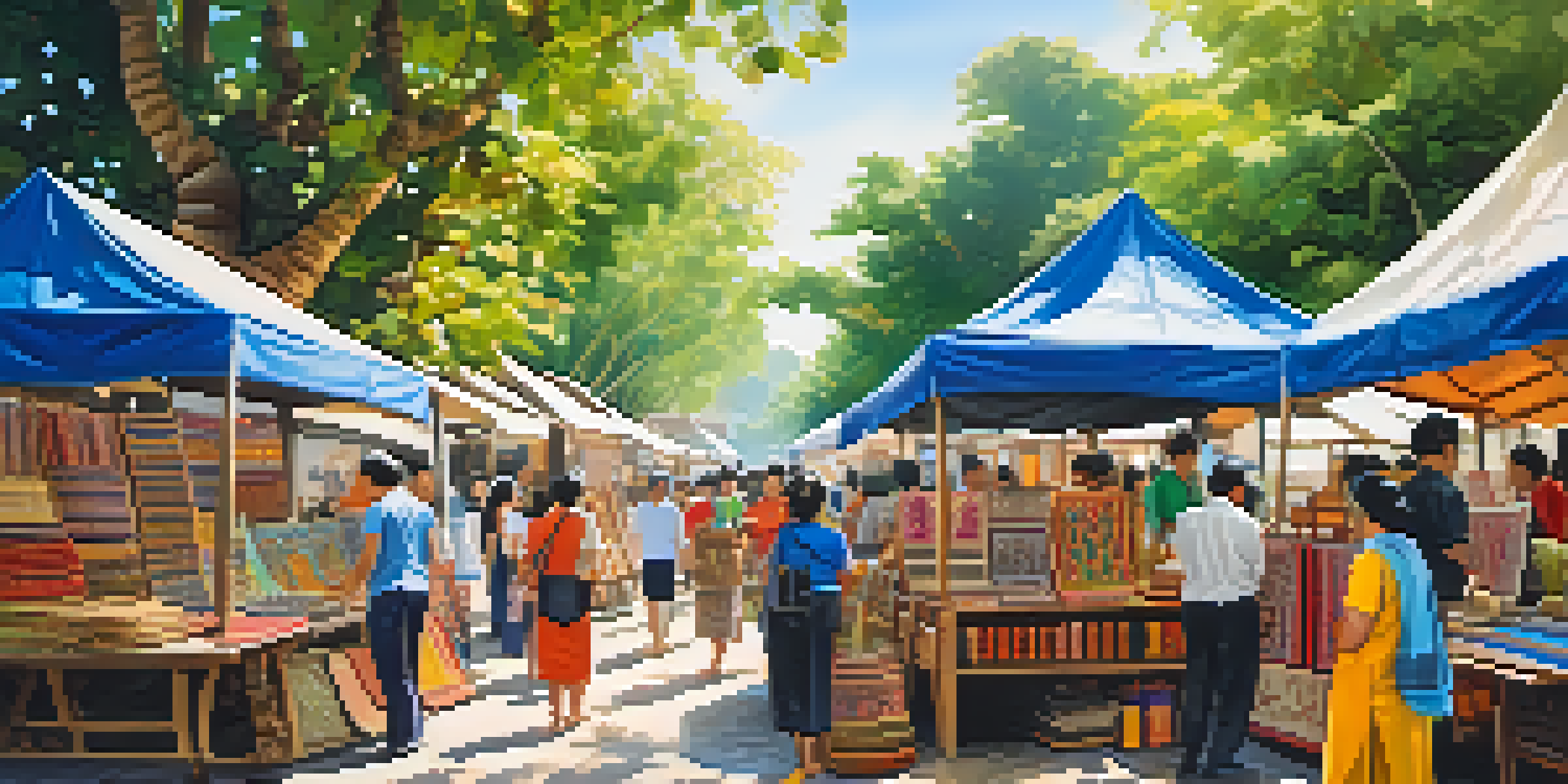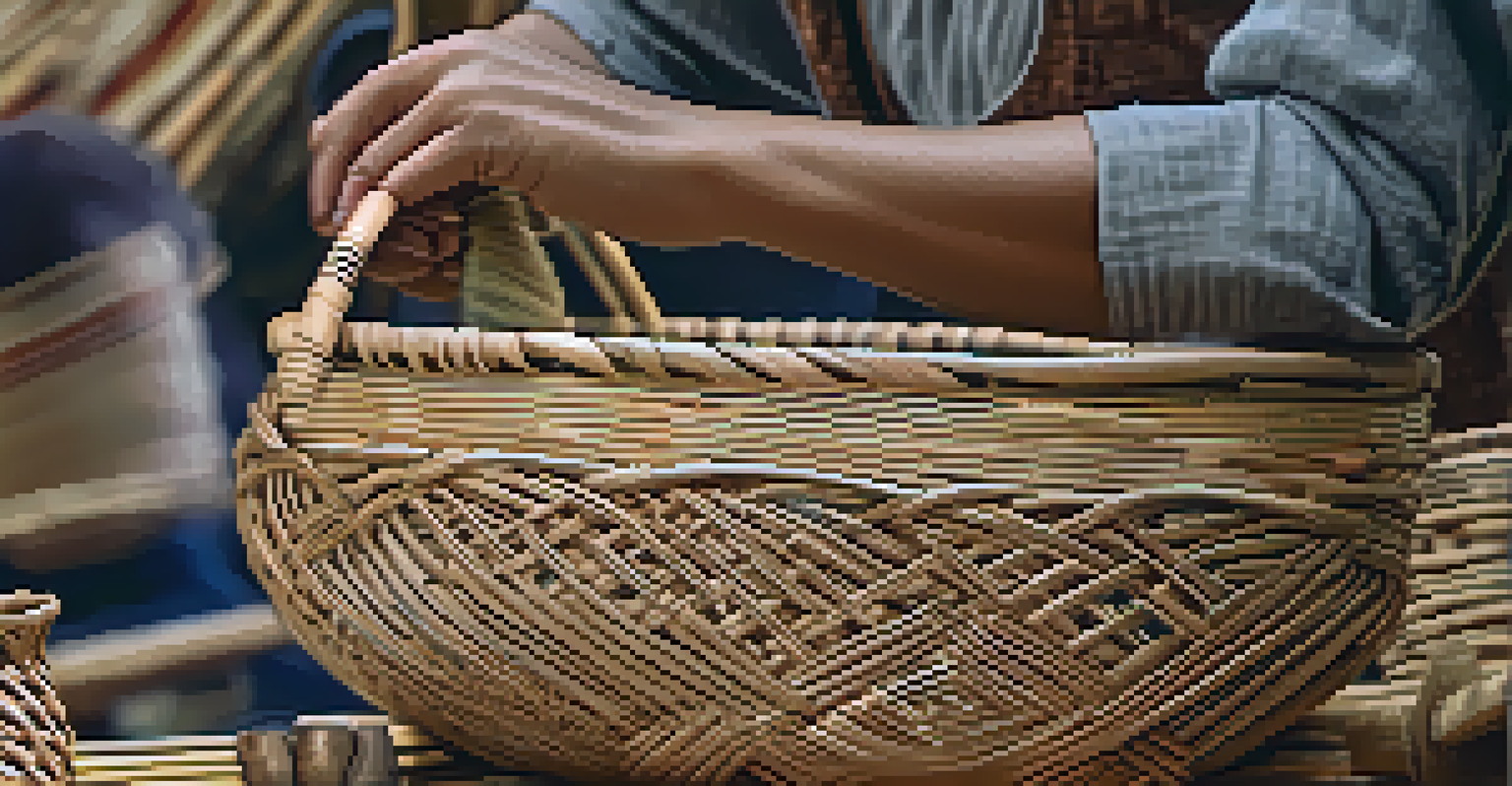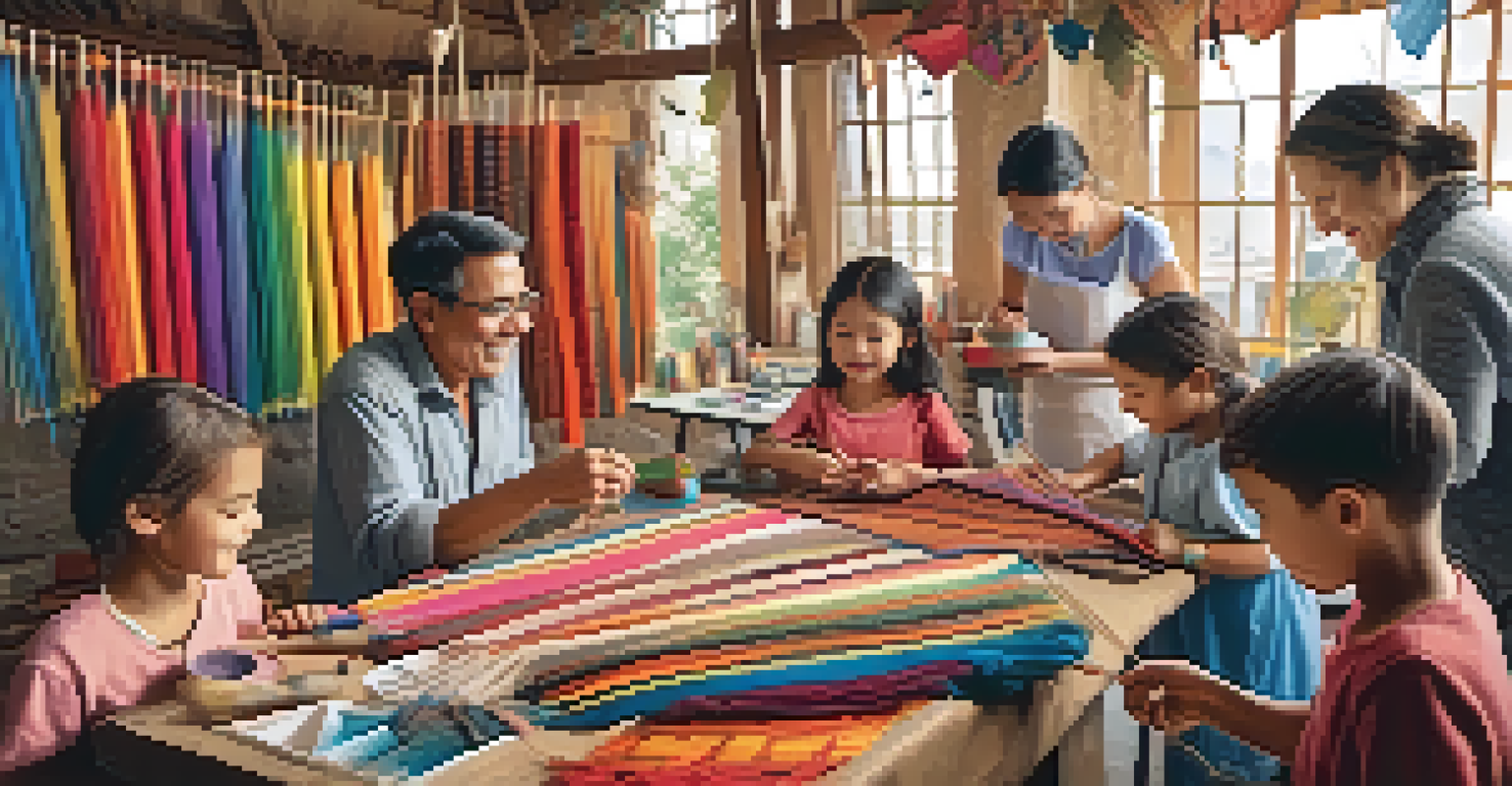The Role of Art and Craft Fairs in Thailand's Cultural Heritage

Understanding the Importance of Art and Craft Fairs
Art and craft fairs in Thailand serve as vibrant platforms for showcasing the country's rich cultural tapestry. These events not only celebrate traditional crafts but also promote contemporary artistic expressions, making them essential to Thailand's cultural identity. By bringing together artisans, artists, and visitors, these fairs foster a sense of community and shared heritage.
Art enables us to find ourselves and lose ourselves at the same time.
At these fairs, you can find everything from intricate hand-woven textiles to stunning ceramics, each piece telling a story of its origin. They highlight the skills passed down through generations, ensuring that traditional crafts remain alive and relevant. This celebration of craftsmanship is not just about art; it's about preserving a way of life.
Moreover, these fairs often feature workshops and demonstrations that engage visitors and create a deeper appreciation for the artistry involved. Participants can learn directly from artisans, which helps to bridge the gap between the creator and the consumer. This hands-on experience emphasizes the importance of cultural heritage and its relevance in today’s world.
Promoting Local Artisans and Sustainable Practices
One of the significant roles of art and craft fairs in Thailand is to promote local artisans and their sustainable practices. These events provide a marketplace where artisans can showcase and sell their creations, helping them to gain visibility and recognition. This support not only empowers local communities but also encourages the preservation of traditional techniques that may otherwise be lost.

By focusing on sustainable practices, these fairs often emphasize environmentally friendly materials and methods. For instance, many artisans use natural dyes and local resources, which helps reduce their carbon footprint. This commitment to sustainability resonates with consumers who are increasingly seeking ethical and eco-conscious options.
Cultural Heritage and Community
Art and craft fairs in Thailand celebrate traditional and contemporary artistry, fostering a sense of community and preserving cultural identity.
Furthermore, these fairs often highlight the importance of fair trade, ensuring that artisans receive a fair wage for their work. This not only supports their livelihoods but also fosters a sense of pride in their craft. As visitors purchase these handmade items, they contribute to a cycle of cultural and economic sustainability, enriching both the community and the consumer.
Art and Craft Fairs as Cultural Exchange Platforms
Art and craft fairs in Thailand also serve as important cultural exchange platforms, attracting both locals and international visitors. These events create an opportunity for diverse cultures to interact, share ideas, and celebrate artistic expressions. As visitors explore different stalls, they can experience the rich variety of Thai art alongside influences from other cultures.
The best way to predict the future is to create it.
This cultural exchange fosters understanding and appreciation for various art forms, encouraging collaboration among artists. For example, a Thai artisan might incorporate techniques learned from international counterparts, leading to innovative creations that blend styles. This cross-pollination of ideas enriches the artistic landscape and promotes a sense of global community.
Additionally, workshops and demonstrations at these fairs allow for direct engagement between cultures. Participants can learn about traditional Thai crafts while sharing their own artistic backgrounds, creating a dialogue that transcends borders. Such experiences not only enhance cultural appreciation but also build long-lasting connections among artists and enthusiasts.
The Economic Impact of Art and Craft Fairs
The economic impact of art and craft fairs in Thailand is significant, contributing to local economies and tourism. These fairs attract thousands of visitors, boosting foot traffic in the areas where they are held. Local businesses, from food vendors to hotels, benefit from the influx of tourists eager to experience Thailand's cultural offerings.
Artisans also experience increased sales and exposure, which can lead to further opportunities, such as collaborations or exhibitions. When artisans succeed, they can invest in their crafts, ensuring the continued growth and evolution of traditional art forms. This economic boost helps sustain the livelihoods of countless families across the country.
Support for Local Artisans
These fairs promote local artisans by providing a marketplace that emphasizes sustainable practices and fair trade, empowering communities.
Moreover, as these fairs gain popularity, they enhance Thailand's reputation as a destination for cultural tourism. Visitors who attend these events often leave with a deeper appreciation for Thai culture and may return to explore more of what the country has to offer. This cycle of tourism and community support reinforces the importance of art and craft fairs in Thailand's economy.
Fostering Creativity and Innovation Through Community
Art and craft fairs in Thailand are not only about preserving tradition; they also foster creativity and innovation within the community. These events provide a space for artists to experiment with new ideas and techniques, often leading to fresh interpretations of traditional crafts. This creative environment encourages artisans to push boundaries and explore new artistic avenues.
In many cases, fairs host competitions or exhibitions that highlight innovative works, inspiring artists to take risks and think outside the box. By showcasing contemporary interpretations of traditional crafts, these events help bridge the gap between the past and the present. This dynamic interplay encourages a culture of ongoing artistic evolution, ensuring that Thai art remains vibrant and relevant.
Additionally, the interactions among artists at these fairs can spark collaborations and joint projects, further enhancing the creative landscape. As artisans share their unique skills and ideas, they contribute to a collective growth that benefits the entire community. This spirit of collaboration and innovation is essential for keeping the arts alive and thriving in Thailand.
Connecting Generations Through Art and Craft
Art and craft fairs in Thailand play a vital role in connecting generations through shared artistic experiences. These events often feature workshops and activities designed for all ages, allowing families to bond over the creation of art. This connection helps instill a sense of pride in cultural heritage, as younger generations learn about the crafts that have shaped their identity.
By involving children and young adults in hands-on activities, these fairs nurture an appreciation for traditional crafts and the stories behind them. For example, a child might learn to weave a basket while listening to their grandparent recount stories of how that craft has evolved over the years. This storytelling aspect enriches the experience and deepens the connection to cultural roots.
Economic Growth Through Tourism
Art and craft fairs significantly contribute to local economies by attracting tourists, boosting sales for artisans, and supporting surrounding businesses.
Moreover, as older artisans pass down their skills to younger generations, they ensure that traditional knowledge is preserved. This intergenerational exchange not only keeps traditions alive but also fosters respect and understanding between age groups. Ultimately, art and craft fairs become a celebration of shared history and the continuity of cultural practices.
The Future of Art and Craft Fairs in Thailand
Looking ahead, the future of art and craft fairs in Thailand appears promising, as they continue to evolve and adapt to changing times. With the rise of digital platforms, many artisans are now showcasing their work online, expanding their reach beyond physical fairs. This shift allows for greater accessibility and exposure, ensuring that traditional crafts find new audiences.
However, the essence of in-person fairs remains irreplaceable, as they provide unique opportunities for direct interaction and cultural exchange. Organizers are increasingly incorporating technology to enhance the visitor experience, such as virtual tours or interactive workshops. This blend of tradition and innovation ensures that these fairs remain relevant in a rapidly changing world.

As awareness grows about the importance of preserving cultural heritage, support for these fairs is likely to increase. By attracting more visitors and sponsors, art and craft fairs can further empower local artisans and sustain their practices. The ongoing commitment to celebrating and preserving Thailand's artistic legacy ensures that these fairs will continue to play a crucial role in the country's cultural landscape.